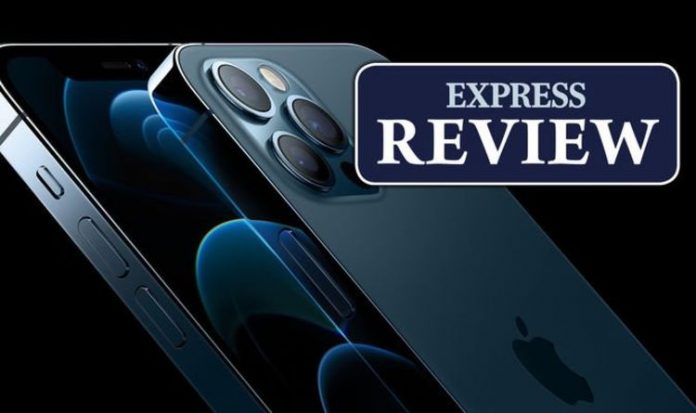Apple iPhone 12 Pro review (Image: APPLE)
It’s taken a little longer than usual, but Apple fanatics will finally get their hands on the iPhone 12 Pro later this week. The upgraded flagship has received a serious boost this year, thanks to the faster A14 Bionic processor, improved triple-lens rear-camera, and access to 5G data speeds, which make downloading movies quicker than your home broadband.
With a pretty extensive list of shiny new features, iPhone 12 Pro certainly sounds enticing on paper, but with the iPhone 12 now sharing many of the same upgrades at a much cheaper price – is it really worth paying the premium for the “Pro” version of the iPhone?
Express.co.uk has been putting the Pro through its paces since it was revealed last week and here’s our full review.
iPhone 12 Pro review: Design and Display
Since the dramatic design shake-up that arrived with the launch of the iPhone X, Apple has dept its design pretty consistent over the last few years. In 2020, that’s changed. Apple has clearly looked for inspiration with its much-loved iPhone 4 and iPhone 5 when designing this latest model.
That means iPhone 12 Pro gets a sharper and more industrial finish with the gentle curves of its predecessor replaced with more angular, flat edges around the side. There are also some new colours this year, including the stunning Pacific Blue, which is the design we’d recommend.
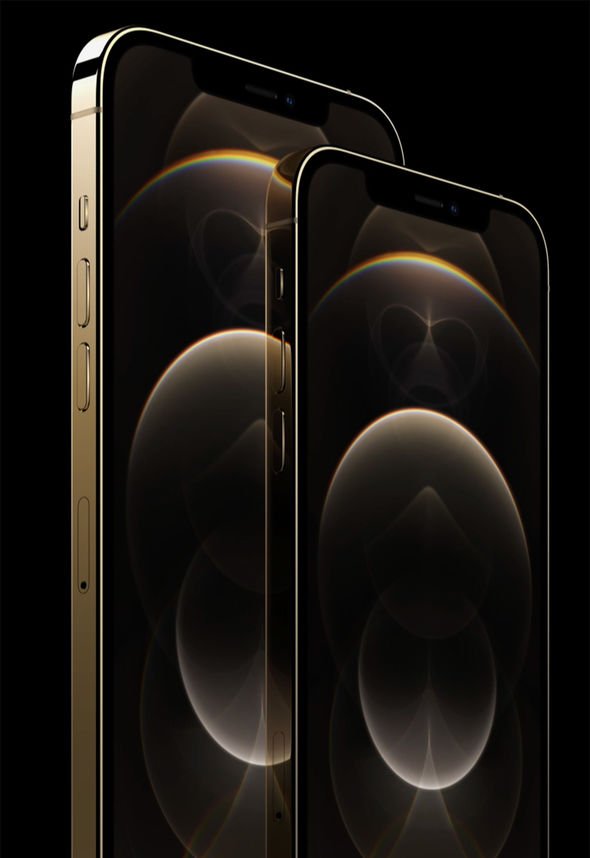
Apple iPhone 12 Pro comes in a number of stunning colours (Image: APPLE)
Unlike the iPhone 12, which gets a glossy rear case and a matte aluminium band around the sides, iPhone 12 Pro has the exact opposite – a shiny stainless steel edge and more subdued frosted glass shell on the back. Apple used the same treated glass on the back of the iPhone 11 Pro and it doesn’t feel as slippery and some glass smartphones – good news for anyone who prefers to leave the case at home.
There’s also a triple rear-camera on the back like last year. We really like this updated design – the sharper feel is exactly what we’d been hoping for and it doesn’t disappoint when you get it in your hands. If you’ve been a fan of the recent iPad Pro stylings, this is the iPhone for you.
Something else everyone will love is the Super Retina XDR display, which still packs the same OLED technology as last year’s 11 Pro. Colours look vibrant on the 6.1-inch screen with rich blacks and content appearing pin-sharp and crystal clear. Like most Apple products, the touchscreen includes True Tone technology, which subtly adjusts the white balance to match the colour temperature of the room around you. In a nutshell, it means the screen should always appear less harsh – or blue – on your eyes when working in dingier rooms.
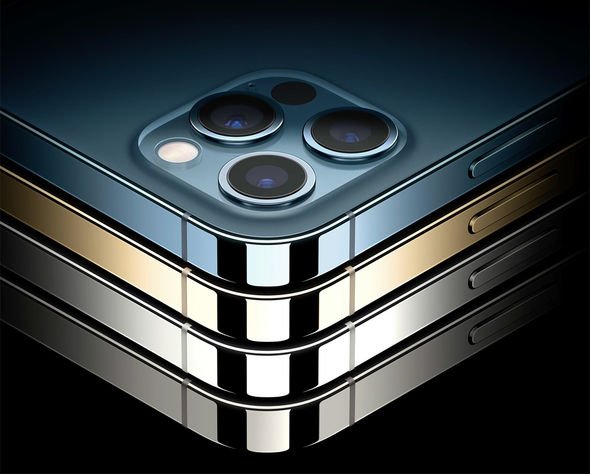
The Apple iPhone 12 Pro gets a more angular design (Image: APPLE)
So, it’s very positive for the design and display but we do have one gripe.
For some reason, Apple has kept the refresh rate at 60Hz, which doesn’t seem right given the “Pro” price and “Pro” branding on this handset. The vast majority of rival devices charging £999 or more now include 120Hz panels and you can really notice the difference when scrolling through websites, skim-reading text in longer emails. Gamers who subscribe to Apple Arcade will also miss the faster refresh rate.
Apple is aware of how brilliant 120Hz panels can be – as the company was one of the pioneers of this technology when it introduced it to the iPad Pro a few years ago. Given the shared “Pro” branding between this premium tablet and the latest smartphone, it seems odd Apple hasn’t included it.
Aside from the standard 60Hz refresh-rate, the OLED display is excellent – it’s bright enough to stay visible outdoors, has great viewing angles and the blacks are cavernous when using Dark Mode, which should be a real battery-life saver too!
One thing that has improved on the latest iPhone range is durability. Apple now includes a new “Ceramic Shield” glass, which is much stronger than previous iPhone models. In fact, Apple is boasting that it has four times better drop performance than iPhone 11 Pro.
During our testing, we managed to (accidentally) drop the Pro on a concrete path and it survived the ordeal fully intact. We did have a case on the smartphone, but the iPhone landed on its screen …so it seems the claim of a stronger build could well be true, although we don’t recommend conducting your own tests to find out.
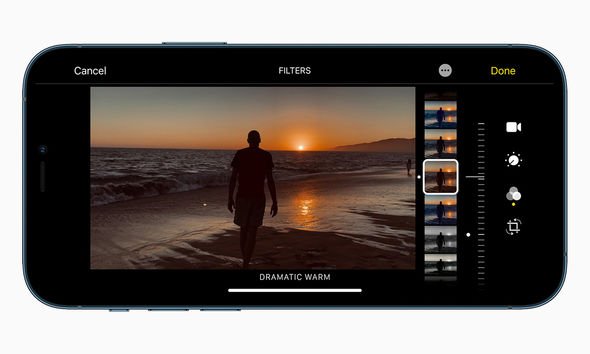
Apple iPhone 12 Pro gets an updated rear camera (Image: APPLE)
iPhone 12 Pro review: Camera
The new Pro features a similar camera set to last year, packing a triple-lens system on the rear case. Powered by the A14 chip, it offers the usual Ultra Wide, Wide, and Telephoto shots as well as Night and Portrait modes. As with last year’s iPhone 11 Pro, this new device will take some stunning shots without asking you to think about toggling with any settings – exactly what most of us want.
However, given that this is a “Pro” smartphone, it might be nice for Apple to launch a dedicated mode within its camera app for photography gurus to tweak every setting to get the exact shot they want. Granted, there are third-party apps that offer this – but given that the camera is one of only a few differences between the standard iPhone 12 and its “Pro” counterpart, it might be fun to see that difference reflected in the software too.
Images from the 12 Pro look pin-sharp and packed with detail. Colours are warmer than some rivals, but that’s no bad thing. The biggest change between the 11 Pro and the new model is the f/1.6 aperture on the Ultra Wide camera, which delivers 27 percent improved low-light performance.

Apple iPhone 12 Pro camera test (Image: EXPRESS NEWSPAPERS)

iPhone 12 Pro camera sample (Image: EXPRESS NEWSPAPER)


There’s also some impressive image stabilisation for a smooth look to your films as well as the usual slow-motion and Time Lapse modes.
One final thing to note about the rear camera is that, in the future, it will allow users to shoot in an Apple-designed RAW format, which allows photographers to edit their images without degrading the quality of the image. This is sure to go down well with budding photographers, although it isn’t quite ready yet – so we weren’t able to test it with our review unit.
If you love a selfie, the biggest change to the front-facing camera is the addition of Night Mode, which means you can snap a photo of your face without needing a flash. It works supremely well and we can see this being a much-used feature for those that love the perfect pose for Instagram.

The iPhone 12 Pro now takes better photos at night (Image: APPLE)

The LiDAR scanner helps shoot portrait shots at night (Image: EXPRESS NEWSPAPER)
You can also use Apple’s clever Night Mode with this camera for the first time, which is a nice addition when shooting low light landscapes or large groups of socially distant chums.
Another aspect that’s improved is the addition of the LiDAR scanner on this device. This depth sensor was first revealed on the iPad Pro earlier this year and not only improves Augmented Reality (AR) capabilities but also allows you to add portrait effects when shooting in Night Mode.
It’s a really nice bonus and we’ve managed to take some impressive photos in the dark with very little fuss. If you’ve tried to take a Portrait Mode image in gloomy restaurants or bars, you’ll know how much the iPhone can struggle to find focus – often leaving the background and the subject blurred. So, that is a really nice fix. Since it relies on the LiDAR scanner to work, iPhone 12 owners won’t get this benefit.
If movies are your passion, the improved triple-camera can now record in Dolby Vision HDR at 60 frames-per-second which captures 60x more colours. iPhone 12 Pro can also edit encoded Dolby Vision videos right on the device, which has never been possible until now.
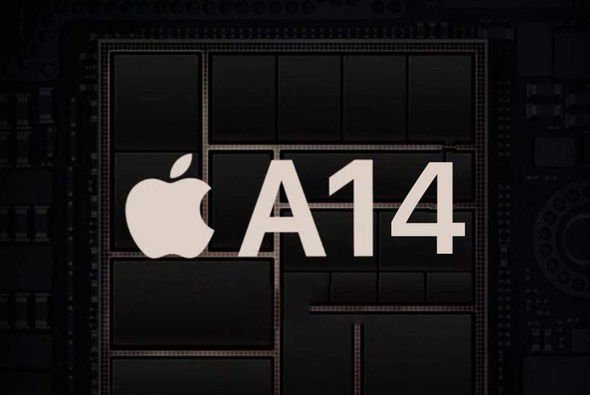
The Apple iPhone 12 Pro gets an A14 Bionic processor (Image: APPLE)
iPhone 12 Pro review: A14 Processor
If you want the most powerful iPhone in town, the Pro is not going to disappoint. All of Apple’s 2020 flagships now pack the A14 Bionic chip under their glass and metal bodies and performance is mightily impressive.
Everything you do on the iPhone 12 Pro feels fast and stutter-free and you’ll have no problems playing high-performance games, quickly switching between numerous apps, or editing Dolby Vision footage without pulling a MacBook from your bag.
Apple is confident this is the fastest chip in any smartphone as it’s the first built using a 5nm process, which has enabled the company to make the chipset faster – and much more efficient.
The iPhone 11 Pro was already supremely powerful and the A14 Bionic is going to make this latest device very tough to beat. We’ve had no issues when it comes to performance and we doubt many users will come close to pushing it to the max.
Unlike the entry-level iPhone 12, the 12 Pro also starts with 128GB of storage as standard and this can be boosted to a whopping 512GB if you think you’ll need it. As always, our advice is to buy the biggest memory you can afford as this will future-proof the phone and save you the pain of endlessly freeing up space on the device.
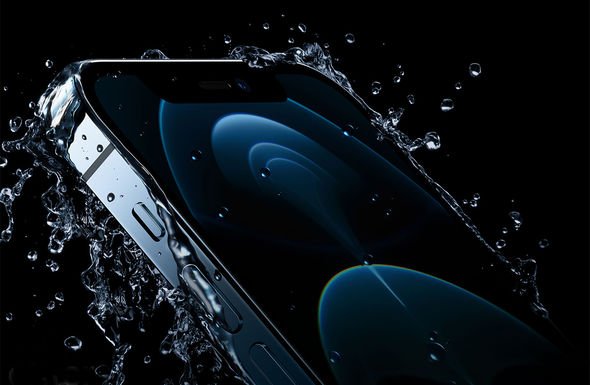
Apple’s iPhone 12 Pro gets a tough new design (Image: APPLE)
iPhone 12 Pro review: Enter 5G
You may have heard plenty of chatter about 5G. And now, your iPhone can finally access these ludicrously fast speeds. The entire family of iPhone 12 devices, including the Pro and Pro Max, all come with 5G as standard and that means you can expect downloads to be whizzed to these phones at speeds of well over 300Mbps – around six times faster than the average UK home broadband can muster.
5G is clearly the future, but there is one thing to be aware of.
Although carriers like EE, Three, O2 and Vodafone continue to boast that their coverage is rapidly expanding across the UK, there’s still vast parts of the country that aren’t close to getting 5G speeds. We’ve been testing the iPhone 12 Pro in Greater London and trying to latch onto one of these superspeedy signals isn’t always easy – even when the coverage map suggests you’re in exactly the right spot to access 5G.
With a bit of hunting, we did manage to track down this signal and witnessed speeds in excess of 130Mbps, which is impressive – but not much more than the 100Mbps maximum you can see on 4G networks.
Of course, over the coming months and years, things will improve and more places will get a 5G signal but if you’re rushing to buy an iPhone 12 Pro and are expecting blisteringly fast downloads then you might be left feeling a little disappointed when all you see is 4G.
There is something else to remember as not all contracts include 5G and you may find you need to pay a little extra each month to access it.
It’s great to see Apple now bringing this technology to its iPhones. There’s just a long way to go until we are all going to get the full benefit of this ultimate network technology.
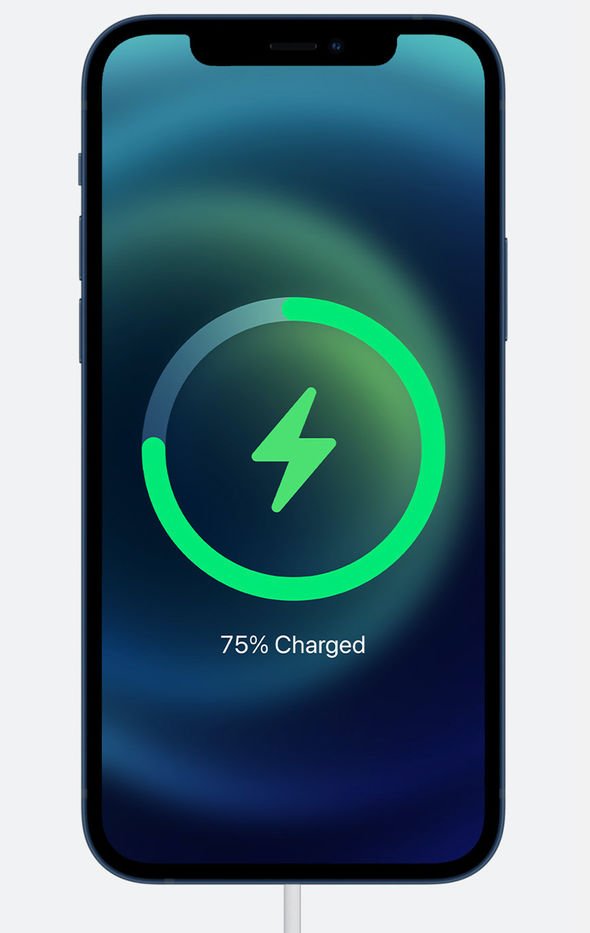
The iPhone 12 Pro now gets MagSafe charging (Image: APPLE)
iPhone 12 Pro review: Battery, Magsafe
Apple’s iPhone 11 Pro already made some impressive gains when it came to battery life, but it hasn’t rested on its laurels with the 12 Pro.
During our tests, this new smartphone easily powered us through a day and we even managed to get well into a second without going near a plug.
It’s very impressive and we’re guessing the efficiency of the A14 Bionic processor has something to do this extended battery life. When things do finally run low, iPhone 12 Pro includes the usual wireless and wired fast-charging. But this year, there’s a new addition with the introduction of a MagSafe charger. This clever cable and disc snaps to the back of the case using magnets and offers faster wireless charging speeds.
It does cost an extra £39, but it’s worth investing if you want the best wireless charging experience for your shiny new phone. It’s worth noting that the speedy wireless charging speeds are only available with Magsafe, which is a limit put in place by Apple.
Another thing you’ll need to remember is that iPhone 12 Pro doesn’t ship with a charger in the box. Yes, the rumours were true, Apple has removed the white power plug in a bid to reduce electronic waste and also to cut down on the size of the packaging that it needs to ship its devices across the globe.
It makes a lot of sense as most people have enough chargers littering the drawers in their homes, but one thing you might find a little annoying is the charging cable that now comes bundled with the iPhone 12 Pro.
Apple has included a USB-C to Lightning port, which means the new cable in the box won’t fit with any of the plugs bundled with your previous iPhones, which were always USB-A.
Of course, the new USB-C cable that comes with the iPhone does offer faster-charging speeds via Apple’s improved 20-watt plug and, if you own a MacBook or iPad Pro you can now charge your iPhone with the much faster USB-C charging brick that ships with these devices.
Just be aware that you might end up heading back to the Apple Store and adding a £19 plug to your shopping basket. Oh, and while you’re there – you might want to pick up a pair of £159 AirPods too as Apple has dropped the wired Lighting connector headphones from the box too.
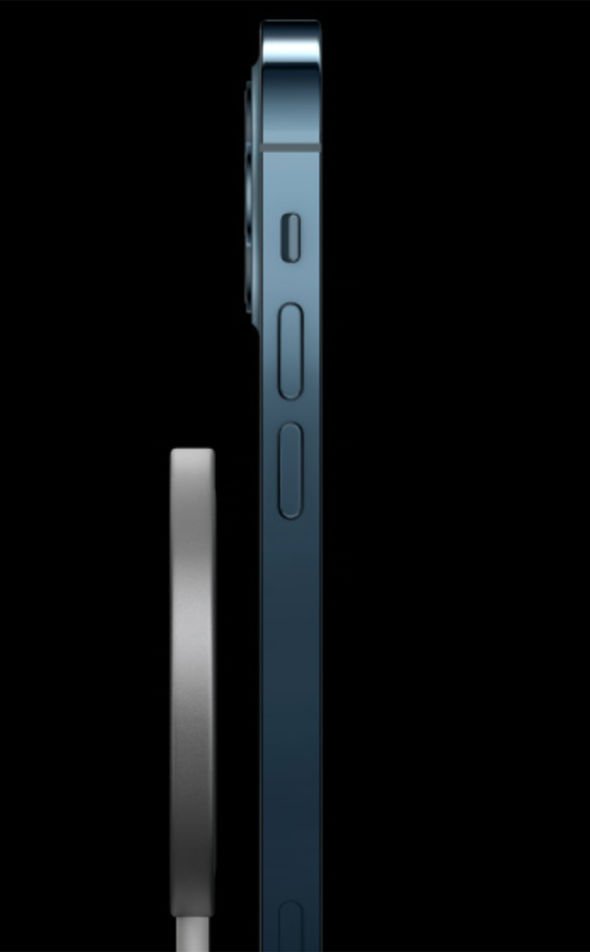
Apple iPhone 12 Pro review (Image: APPLE)
iPhone 12 Pro review: UK Price
The iPhone is, of course, packed with plenty of new features but despite all of this extra tech, Apple has kept the price the same. That means you can pop the iPhone 12 Prio in your pocket for £999.
Of course, the more storage you add to your iPhone model, the higher the price – and you might need to invest in a new charging plug and headphones, which could make this a pricier upgrade than previous years.
One thing that’s worth noting is that the standard iPhone 12 starts from £799 for a 64GB configuration and iPhone 12 Mini boasts a £699 starting price. Despite the lower cost, both of these smartphones offer many of the features found on the Pro, including the stunning edge-to-edge OLED display, Face ID scanner, MagSafe charging, 5G download speeds, long battery life and record-beating A14 processor.
You just need to decide whether the lossless zoom enabled by the Telephoto camera in the triple-camera, increased storage options, frosted glass finish, and Night Mode Portrait images are worth the extra expense.
iPhone 12 Pro review: Final Verdict
There’s no question that iPhone 12 Pro is a solid upgrade. Apple’s new design looks absolutely stunning while the A14 Bionic ensures even the most taxing AR app loads in seconds and the battery life is so good you can leave your charger at home even on weekends away!
The triple rear-camera has been improved, especially when shooting in low-light conditions and there’s now full access to 5G – so you’ll be ready to download at supercharged speeds whenever coverage reaches your local area.
Clearly, there’s plenty to like, but we’ve been left wondering whether we’d recommend buying an iPhone 12 Pro. Honestly, it’s been a struggle – and that’s not because the iPhone 12 Pro is bad, but it’s because the new entry-level iPhone 12 is so phenomenally good.
iPhone 12 received a huge upgrade this year and now enjoys many of the same features found on the Pro – something that wasn’t true with the iPhone 11 and iPhone 11 Pro last time around. The entry-level iPhone boasts the same stunning OLED screen, superfast A14 Bionic processor, 5G support, stronger “Ceramic Shield” design and MagSafe charging.
And you’ll get all of that for £200 less than the iPhone 12 Pro. Not only that, but things will get even cheaper when the iPhone 12 Mini launches in November from £699.
Of course, if you want the best iPhone on the market right now, then the iPhone 12 Pro won’t disappoint. And if you’re excited by the prospect of shooting Dolby Vision footage at 60 frames-per-second, or editing photos in a RAW format on-the-move, then it’s not worth considering the standard iPhone 12. However, we wish Apple had added a few extra features to make it easier for the rest of us to see why the iPhone 12 Pro is so much better than its feature-packed (and considerably cheaper) sibling.

